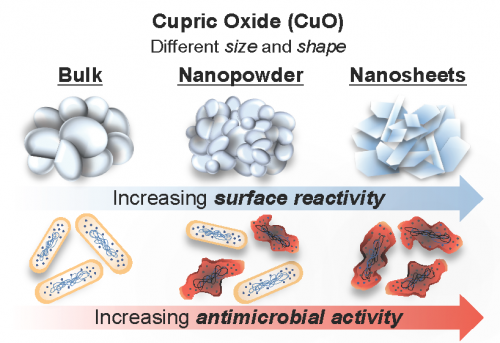
A collaborative team of researchers in the Department of Chemical & Environmental Engineering has elucidated the connection between the shape of cupric oxide nanomaterials and their functional efficiency. Led by Leanne Gilbertson, now Assistant Professor of Civil and Environmental Engineering at the University of Pittsburgh, the team demonstrates that the antimicrobial activity, electrochemical activity and catalytic reactivity of cupric oxides increases when the shape is adjusted from bulk suspended material to nanomaterials like nanopowder and nanosheets.
Shape-dependent surface reactivity and antimicrobial activity of nano-cupric oxide
Leanne M. Gilbertson, Eva M. Albalghiti, Zachary S. Fishman, Francois Perrault, Charlie Corredor, Jonathan D. Posner, Menachem Elimelech, Lisa D. Pfefferle, Julie B. Zimmerman
Abstract:
Shape of engineered nanomaterials (ENMs) can be used as a design handle to achieve controlled manipulation of physicochemical properties. This tailored material property approach necessitates the establishment of relationships between specific ENM properties that result from such manipulations (e.g., surface area, reactivity, or charge) and the observed trend in behavior, from both a functional performance and hazard perspective. In this study, these structure property-function (SPF) and structure-property-hazard (SPH) relationships are established for nano cupric oxide (n-CuO) as a function of shape, including nano-spheres and nano-sheets. In addition to comparing these shapes at the nano-scale, bulk CuO is studied to compare across length scales. The results from comprehensive material characterization revealed correlations between CuO surface reactivity and bacterial toxicity with CuO nanosheets having the highest surface reactivity, electrochemical activity, and antimicrobial activity. While less active than the nanosheets, CuO nanoparticles (sphere-like shape) demonstrated enhanced reactivity compared to the bulk CuO. This is in agreement with previous studies investigating differences across length-scales. To elucidate the underlying mechanisms of action to further explain the shape dependent behavior, kinetic models were applied to the toxicity data, which revealed that trends in observed response cannot be explained by surface area alone. The compiled results contribute to further elucidate pathways towards controlled design of ENMs.